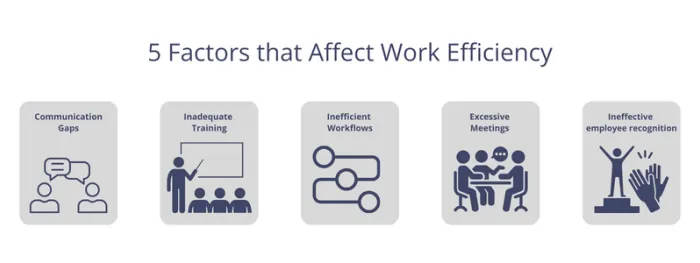Overcoming Common Obstacles to Workplace Efficiency
Table of contents

No time to read? Sit back and listen to this article.
Nutrient Workflow(opens in a new tab) · Overcoming Common Obstacles To Workplace Efficiency(opens in a new tab)
All workers, regardless of position, department, or industry, are bound to run into roadblocks. These obstacles often cause delays, low morale, inefficient workflows, and high turnover rates. If workers are not meeting expected goals, sometimes it may not be in their control. There might be obstacles in the workplace that are affecting productivity.
Recognizing common obstacles that employees in an organization may face and actionable solutions for overcoming them will put you and your organization in a better position to improve productivity and overall morale.
This article will cover five common roadblocks to efficiency and actionable solutions to overcome them.

Communication or Knowledge Gaps
Employees need to be able to have open communication in the workplace. When workers do not know who to ask for help or where to locate what they are looking for, there is wasted time during the search process.
Another factor that may cause communication gaps is if there is tribal knowledge present in your organization. "Tribal knowledge is any unwritten information not commonly known by others within a company." This often results in only one or a few people in the organization knowing how to perform a specific task. Those who do not know this tribal knowledge spend time searching for answers or the right people to answer their questions.
Solution:
A possible solution would be to have one location that all employees have access to, whether that is organization or department-specific, that has training documents and instructions for frequently used processes. This page can also list expectations, common emails for contacting specific departments, and other information you'd see fit.
One possible solution is ensuring managers can communicate effectively with their employees. Your management team must provide constructive feedback to their employees, and should be accessible to them for coaching as readily as possible. Managers should maintain an open line of communication through employees' preferred mode of communication. This could be email, messaging, video calls, or commenting through work apps.
Inadequate Training
When employees come on board and are not trained with the technology and tools they will use daily, they are likely to make errors and are less productive during the day. This often results in them having to redo work multiple times or ask a co-worker for help, which will then slow down other team members and lower efficiency in numerous workers.
Solution
Take a closer look at your organization's onboarding process. Onboarding sets the tone for the employee's relationship with their new company. Training is the central area of the onboarding process. Onboarding should give all of the information to your new employee that'll empower them to feel confident in their new role.
Inefficient Workflows
Another obstacle that hinders efficiency in the workplace is inefficient workflows. Inefficient processes impact productivity, efficiency, and employee morale. You don't have any more time to struggle through manual, inefficient workflows. Time is wasted when employees don't have visibility into their processes or know what steps to take or tasks to complete.
Inefficient workflows also cause bottlenecks that can lead to delays and impact overall process flow. Having unorganized workflows causes process friction that will negatively impact efficiency, productivity, and overall performance, not just at an employee level but organization-wide.
Solution
Utilize workflow automation tools to create, manage, and track processes, ensuring tasks move smoothly from one stage to another. Streamlining processes sets clear criteria, uses technology for notifications and routing, and eliminates unnecessary steps.
Excessive meetings
Excessive meetings have been more discussed since remote work has become more popular. But the truth is that having multiple back-to-back meetings is doing more harm than good. 70% of employees(opens in a new tab) state they don't even think meetings help them get work done. When employees are in meetings throughout the week, it is blocking out time that they could be working on more important tasks that bring more value to the organization.
Meetings are an excellent way to ensure people are on the same page, but other methods of communication take up less of your employees' time.
Solution
Before calling everyone together, consider every angle. Is there a more convenient way of communicating the topic, rather than an hour meeting? This Nutrient Workflow blog covers items to consider before scheduling or attending a conference.
Ineffective employee recognition
When employees don't receive recognition for their exceptional work, they feel overlooked and unappreciated. This often results in a decline in the employee's motivation, or the employee may even search for a new job. People want to feel recognized for their hard work, and if they are not, it may negatively impact your organization. When employees feel overlooked, their efficiency will be affected negatively as well.
Solution
Create a peer recognition program where employees can nominate their co-workers for recognition. Another idea is that your organization could start participating in Employee Appreciation Day, which is on March 1st. Even a quick email thanking your employees can go a long way.
In conclusion, understanding these challenges and implementing solutions can greatly enhance your team's productivity and performance. By being aware of these common roadblocks and knowing how to address them, you can better equip your employees for success.




